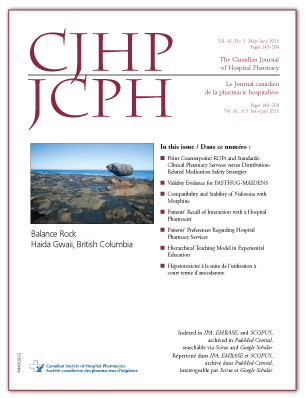Validity Evidence for FASTHUG-MAIDENS, a Mnemonic for Identifying Drug-Related Problems in the Intensive Care Unit
DOI:
https://doi.org/10.4212/cjhp.v66i3.1252Keywords:
drug-related problems, intensive care unit, adverse effects, pharmacist, checklist, patient outcomes, problèmes pharmacothérapeutiques, unité des soins intensifs, effets indésirables, pharmacien, liste de contrôle, résultats thérapeutiquesAbstract
ABSTRACT
Background: The mnemonic FASTHUG (Feeding, Analgesia, Sedation, Thromboembolic prophylaxis, Head of bed elevation, stress Ulcer prophylaxis, Glucose control) was developed by intensive care unit (ICU) physicians to ensure that key aspects of care are addressed during each patient encounter. Because this tool does not specifically target pharmacotherapy assessments, a modified version, FASTHUGMAIDENS, was created, by changing the H to mean Hypoactive or Hyperactive delirium and adding M for Medication reconciliation; A for Antibiotics or Anti-infectives; I for Indications for medications; D for drug Dosing; E for Electrolytes, hematology, and other laboratory tests; N for No drug interactions, allergies, duplication, or side effects; and S for Stop dates.
Objective: To validate the use of FASTHUG-MAIDENS as a tool for identifying drug-related problems (DRPs) in the ICU.
Methods: This randomized, prospective validation study took place between January and May 2011 in the ICUs of 4 hospitals: 2 community-level ICUs and 2 tertiary referral ICUs. Each ICU had a dedicated ICU pharmacist and one or more pharmacy residents completing an ICU rotation as part of their pharmacy practice residency (total of 6 residents). The 6 pharmacy residents were randomly assigned to assess patients admitted to the ICU using FASTHUGMAIDENS or standard monitoring practice. The mean proportion of DRPs per patient encounter identified by the residents (relative to DRPs identified by the ICU pharmacists) was the primary outcome, and the proportion of total DRPs identified in each group was assessed as a secondary end point.
Results: Pharmacy residents using the FASTHUG-MAIDENS mnemonic identified a significantly greater mean proportion of DRPs per patient encounter (73.2% versus 52.4%, p = 0.008) and a greater proportion of total DRPs (77.1% versus 52.5%, p < 0.001) than those assessing patients according to standard monitoring practice.
Conclusion: In this sample, the mnemonic FASTHUG-MAIDENS was a useful tool to facilitate the capture of DRPs by pharmacy residents working in the ICU.
RÉSUMÉ
Contexte : Le code mnémonique anglais FASTHUG (Feeding [alimentation], Analgesia [analgésie], Sedation [sédation], Thromboembolic prophylaxis [prophylaxie thromboembolique], Head of bed elevation [élévation de la tête du lit], stress Ulcer prophylaxis [prophylaxie des ulcères de stress], Glucose control [régulation de la glycémie]) a été imaginé par des médecins intensivistes pour s’assurer que certains aspects clés des soins sont pris en compte pour chaque consultation avec un patient. Comme cet outil ne vise pas spécifiquement les évaluations pharmaco - thérapeutiques, une version modifiée, FASTHUG-MAIDENS, a été créée, où l’on a remplacé le sens du H par Hypoactive or Hyperactive delirium (délire hypoactif ou hyperactif ) et ajouté MAIDENS : Medication reconciliation (bilan comparatif des médicaments); Antibiotics or Anti-infectives (antibiotiques ou anti-infectieux); Indications for medications (indications des médicaments); drug Dosing (posologie des médicaments); Electrolytes, hematology and other laboratory tests (électrolytes, hématologie et autres épreuves de laboratoire); No drug interactions, allergies, duplication, or side effects (absence d’interactions médicamenteuses, d’allergies, de chevauchement ou d’effets secondaires); et Stop dates (dates de fin).
Objectif : Valider l’emploi du code mnémonique FASTHUG-MAIDENS comme outil pour dépister les problèmes pharmacothérapeutiques à l’unité des soins intensifs (USI).
Méthodes : Cette étude de validation aléatoire et prospective a été menée entre janvier et mai 2011 dans les USI de quatre hôpitaux : deux USI de niveau communautaire et deux autres de référence de niveau tertiaire. Chaque USI possédait un pharmacien attitré et au moins un résident en pharmacie complétant un stage à l’USI dans le cadre de leur résidence en pratique pharmaceutique (pour un total de six résidents). Les six résidents en pharmacie ont été assignés au hasard pour évaluer les patients admis à l’USI au moyen du code FASTHUG-MAIDENS ou d’une méthode de suivi standard. Le pourcentage de problèmes pharmaco - thérapeutiques par consultation avec un patient cernés par les résidents (comparativement à ceux constatés par les pharmaciens intensivistes) était le principal paramètre d’évaluation et le pourcentage de problèmes pharmacothérapeutiques totaux relevés dans chaque groupe était le paramètre d’évaluation secondaire.
Résultats : Les résidents en pharmacie qui ont utilisé le code mnémonique FASTHUG-MAIDENS ont cerné un pourcentage moyen significativement supérieur de problèmes pharmacothérapeutiques par consultation avec un patient (73,2 % contre 52,4 %, p = 0,008) et un pourcentage supérieur de problèmes pharmacothérapeutiques totaux (77,1 % contre 52,5 %, p < 0,001) que ceux qui ont évalué les patients au moyen d’une méthode de suivi standard.
Conclusion : Dans cet échantillon, le code mnémonique FASTHUG MAIDENS s’est révélé être un outil utile facilitant la détermination des problèmes pharmacothérapeutiques par les résidents en pharmacie travaillant dans une USI.
Downloads
Published
Issue
Section
License
Copyright © Canadian Society of Healthcare-Systems Pharmacy.
After publication of a manuscript in the CJHP, the authors of the manuscript must obtain written permission from the CSHP (publications@cshp.ca) before reproducing any text, figures, tables, or illustrations from the work in future works of their own. If a submitted manuscript is declined for publication in the CJHP, all said rights shall revert to the authors. Please note that any forms (e.g., preprinted orders and patient intake forms) used by a specific hospital or other health care facility and included as illustrative material with a manuscript are exempt from this copyright transfer. The CJHP will require a letter from the hospital or health care facility granting permission to publish the document(s).










